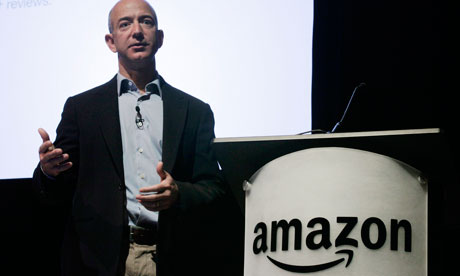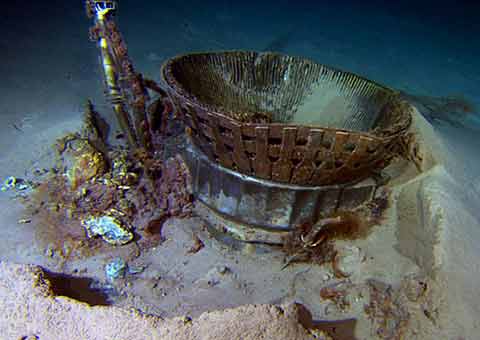Nearly 43 years after they thrust the Apollo 11 astronauts moonwards through a blue Florida sky, the mighty engines that helped deliver man to the Sea of Tranquillity have been found in the depths of the Atlantic Ocean.
The five engines, last seen driving the Saturn V rocket free of the Earth on 16 July 1969, were found in a search led by the Amazon chief executive and space enthusiast Jeff Bezos, who hopes to recover at least one.
The engines took 2½ minutes to hurl the rocket 40 miles into the heavens before falling into the ocean. Four days later, Neil Armstrong and Buzz Aldrin became the first men to walk on the moon.
Bezos – who credits the Apollo 11 mission with fuelling his passion for science, engineering and exploration – embarked on the salvage mission a year ago after deciding it might be possible "with the right team of undersea pros".
"I'm excited to report that, using state-of-the-art deep sea sonar, the team has found the Apollo 11 engines lying 14,000 feet below the surface, and we're making plans to attempt to raise one or more of them from the ocean floor," Bezos wrote in a breathless blog post on Wednesday.
"We don't know yet what condition these engines might be in — they hit the ocean at high velocity and have been in salt water for more than 40 years. On the other hand, they're made of tough stuff, so we'll see."
He gave no details about where the engines had been found, or how they had been identified.
But Bezos did make it clear that he was not claiming ownership of the F-1s and said he hoped they would one day be displayed for the public.
"Though they've been on the ocean floor for a long time, the engines remain the property of Nasa," he said. "If we are able to recover one of these F-1 engines that started mankind on its first journey to another heavenly body, I imagine that Nasa would decide to make it available to the Smithsonian for all to see. If we're able to raise more than one engine, I've asked Nasa if they would consider making it available to the excellent Museum of Flight here in Seattle."
The Amazon founder said the salvage operation was a wholly private affair: "No public funding will be used to attempt to raise the engines."
Nasa said it hadn't been formally contacted by Bezos and was waiting for more details.
A spokesman said: "There has always been great interest in artefacts from the early days of space exploration and his announcement only adds to the enthusiasm of those interested in Nasa's history."
The sea floor is littered with spent rockets and debris from missions dating back to the dawn of the space age. In 1999, a private company salvaged Gus Grissom's Mercury capsule, which accidentally sank in the Atlantic after splashdown in 1961. It was restored and displayed at the Kansas Cosmosphere and Space Centre.
Robert "Bob" Biggs, a development engineer who spent almost a decade working on the F-1, reflected on the engine's sheer power during a Nasa lecture six years ago.
"It took the Apollo launch vehicle, which was 363 feet (110m) tall and weighed six million pounds, and threw it downrange 50 miles, threw it up to 40 miles of altitude, at Mach 7," he said. "It took 2½ minutes to do that and burned 4½ million pounds of propellant – a pretty sizeable task."
Bezos, who founded his own spaceflight company, Blue Origin, "to enable human access to space at dramatically lower cost and increased reliability", described the F-1 rocket engine as an enduring technological marvel.
"The F-1 rocket engine is still a modern wonder – 1½ million pounds of thrust, 32 million horsepower, and burning 6,000 pounds of rocket grade kerosene and liquid oxygen every second," he wrote on his blog. "Those five F-1s burned for just a few minutes, and then plunged back to Earth into the Atlantic Ocean, just as Nasa planned. A few days later, Neil Armstrong stepped onto the moon."
The Apollo programme, he went on, had exercised a profound influence over his life.
"Nasa is one of the few institutions I know that can inspire five-year-olds," he said. "It sure inspired me, and with this endeavour, maybe we can inspire a few more youth to invent and explore."
Boy's toys
Jeff Bezos is not the first extraordinarily rich individual to harbour a penchant for extreme engineering and exploration. Howard Hughes pushed the aeronautical envelope in the 1930s and 1940s by designing and flying experimental aircraft, including the Hughes H-4 Hercules – better known as the Spruce Goose – which was the largest flying boat ever built.
James Cameron, the director of Titanic and The Abyss, is another member of the very rich adventurers' club. Last week, Cameron became the first person to perform a solo voyage to the oceans' deepest point– the floor of the seven-mile deep Mariana Trench. Emerging from his 12-tonne, lime green submarine, Deepsea Challenger, the film-maker described the trench as "a very desolate place… My feeling was one of complete isolation from all of humanity".
Sir Richard Branson – no stranger to perilous endeavours – has also been building his own one-man sub to explore the ocean depths later this year. His Virgin Oceanic deep-diving programme was to have started with a descent to the bottom of the Mariana Trench, but Branson will now pilot his submersible to the Puerto Rico Trench, the deepest point of the Atlantic Ocean.











